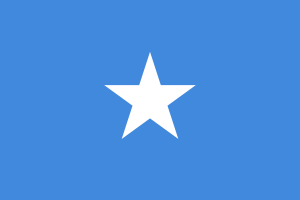Language/Somali/Vocabulary/Meals-and-Dining
| ◀️ Fruits and Vegetables — Previous Lesson | Next Lesson — Greetings and Etiquette ▶️ |
Introduction[edit | edit source]
In this lesson, we will delve into the world of Somali cuisine and explore the vocabulary related to meals and dining. Food is an integral part of Somali culture, and understanding the language associated with it will not only help you communicate effectively in Somali-speaking communities but also provide insights into the rich culinary traditions of Somalia. By the end of this lesson, you will be able to confidently discuss meals, order food at a restaurant, and engage in conversations about dining experiences.
Somali Vocabulary for Meals and Dining[edit | edit source]
Basic Vocabulary for Meals[edit | edit source]
Let's start by learning the basic vocabulary for the three main meals of the day:
Breakfast[edit | edit source]
Breakfast in Somali is called "quraac" or "quraacada." It is typically a light meal that provides energy to start the day. Here are some common breakfast items:
| Somali | Pronunciation | English |
|---|---|---|
| qado | /ḳaḍo/ | tea |
| shax | /shaḥ/ | bread |
| subag | /suḇag/ | porridge |
| bariis | /baris/ | rice |
Lunch[edit | edit source]
Lunch in Somali is called "qado." It is the main meal of the day and is usually eaten around midday. Here are some common lunch items:
| Somali | Pronunciation | English |
|---|---|---|
| suqaar | /sukar/ | meat stew |
| canjeelo | /canjeelo/ | Somali pancakes |
| saliid | /saliːd/ | salad |
| digaag | /diḡaːg/ | chicken |
Dinner[edit | edit source]
Dinner in Somali is called "casho." It is the final meal of the day and is often served in the evening. Here are some common dinner items:
| Somali | Pronunciation | English |
|---|---|---|
| canjeelo | /canjeelo/ | Somali pancakes |
| cambuulo | /ḳambuːlo/ | mashed beans |
| malawah | /malawaḥ/ | Somali crepes |
| suugo | /suːɡo/ | pasta |
Vocabulary for Utensils and Table Settings[edit | edit source]
Now that we know the basic vocabulary for meals, let's move on to the utensils and table settings commonly used in Somali dining:
Utensils[edit | edit source]
Here are some essential utensils used in Somali dining:
- "farko" - fork
- "qabow" - spoon
- "qaad" - knife
Table Settings[edit | edit source]
Somali table settings are often simple and functional. Here are some key terms related to table settings:
- "daawo" - plate
- "qudh" - cup
- "dhoof" - saucer
- "bakhaar" - bowl
Cultural Insights[edit | edit source]
Somali cuisine is heavily influenced by Somali traditions, as well as Arab, Persian, Indian, and Italian culinary practices. The flavors and ingredients used in Somali dishes reflect the country's geography and historical trade routes. For example, Somalia's coastal location means that seafood, such as fish and lobster, is a common part of the diet for people living in coastal regions. In contrast, people in the interior regions rely more on meat, milk, and grains.
Hospitality is highly valued in Somali culture, and sharing a meal is an important social activity. It is common for Somalis to eat together from a communal dish, such as a large platter of rice and meat, using their right hand. This practice fosters a sense of community and strengthens social bonds.
Practice Exercises[edit | edit source]
Now it's time to put your knowledge into practice! Try these exercises to reinforce your understanding of Somali vocabulary for meals and dining:
1. Match the Somali breakfast item with its English translation:
| Somali | English |
|---|---|
| qado | tea |
| shax | bread |
| subag | porridge |
| bariis | rice |
Solution: - qado: tea - shax: bread - subag: porridge - bariis: rice
2. Fill in the blank with the appropriate Somali word for "spoon":
"I need a ______ to eat the soup."
Solution: "I need a qabow to eat the soup."
3. Imagine you are at a Somali restaurant. Create a dialogue where you order a traditional Somali dish for dinner. Use the vocabulary and phrases you have learned in this lesson.
Solution: Customer: "Can I have malawah for dinner, please?" Waiter: "Sure, would you like any sides with that?" Customer: "Yes, I would like a plate of cambuulo as well." Waiter: "Great! Your order will be ready shortly."
Conclusion[edit | edit source]
Congratulations! You have successfully learned the Somali vocabulary for meals and dining. You can now confidently discuss different meals, order food at a restaurant, and engage in conversations about dining experiences in Somali-speaking communities. Keep practicing and exploring Somali cuisine to deepen your understanding of the language and culture. In the next lesson, we will continue our language journey by exploring another exciting topic.
Sources[edit | edit source]
- English-Somali Dictionary | Migration Stories
- English to Somali Meaning of eating - cunidda
- Somali Culture - Etiquette — Cultural Atlas
Other Lessons[edit | edit source]
- Drinks
- Count to 10
- Family and Relatives
- How to Say Hello and Greetings
- Animals
- Colors
- Food
- Modes of Transportation
- Offering or asking for help
- Directions and Locations
| ◀️ Fruits and Vegetables — Previous Lesson | Next Lesson — Greetings and Etiquette ▶️ |

